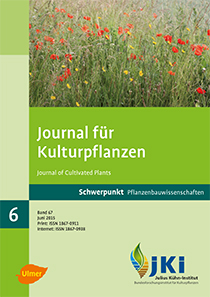Simplified method for quantifying and evaluating the hydraulic properties of potting soils and gardening substrates in horticulture
Keywords:
Soilless media, gardening substrates, potting soils, water retention curve, water capacity, air capacity, unsaturated hydraulic conductivity, extended evaporation method (EEM), HYPROP, shrinkage, water drop penetration timeAbstract
Gardening substrates are produced for horticultural use as a mixture of different organic and mineral ingredients. 18 commercial gardening substrates were hydraulically investigated during this study. The aims of the study were (i) to examine the extended evaporation method (EEM) for quantifying the hydraulic properties of gardening media and (ii) to discuss and evaluate the results in terms of their suitability for horticulture. The variables for the hydraulic evaluation were (i) the easily plant available water, (ii) the air capacity, and (iii) the capillary rise. Additionally, the shrinkage and the rewetting time were quantified as limiting factors. The hydraulic evaluation was applied separately for cultivation in containers and in the ground (free drainage). The hydraulic properties were measured with the HYPROP system (HYdraulic PROPerty analyser), which is methodologically based on the extended evaporation method (EEM). HYPROP enables the simultaneous measurement of the water retention curve and the unsaturated hydraulic conductivity function of 250 cm3 substrate samples close to the wilting point. The measurement varies between 3 and 10 days. Multiple soil or substrate samples can be studied simultaneously, and shrinkage can be measured. The rewetting behaviour was quantified using the water drop penetration time method. This measurement was applied during the evaporation experiment. This means that all required information could be determined during the evaporation experiment. The saturated water content of the samples varied between 71.8 and 87.1% by vol. Most of the tested substrates guaranteed a supply of water. However, the air capacity in containers was a critical factor. For more than 50% of the investigated substrates the water capacity was lower than the threshold value of 10% by vol. It was found that substrates without clay but containing coir, perlite, compost and a small amount of bog peat generally achieved air capacities greater than 10% by vol. The shrinkage and rewetting time also revealed evaluation-relevant differences between the substrates investigated. A more effective evaluation of the hydraulic suitability of soilless media in horticulture requires the development of an evaluation framework. The assessment of the individual values should be based on accepted threshold values, and the suitability should be evaluated based on a point scale.
DOI: 10.5073/JfK.2015.06.02, https://doi.org/10.5073/JfK.2015.06.02
Downloads
Published
Issue
Section
License
The content of the journal is licensed under the Creative Commons Attribution 4.0 License. Any user is free to share and adapt (remix, transform, build upon) the content as long as the original publication is attributed (authors, title, year, journal, issue, pages).
The copyright of the published work remains with the authors. The authors grant the Journal of Cultivated Plants, the Julius Kühn-Institut and the OpenAgrar repository the non-exclusive right to distribute and exploit the work.







